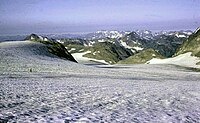
How allogenic factors affect succession in glacier forefields
Sign Up to like & getrecommendations! Published in 2021 at "Earth-Science Reviews"
DOI: 10.1016/j.earscirev.2021.103642
Abstract: Abstract In glacier forefields, the chronosequence approach is used to investigate ecological, biogeochemical and physical features of autogenic successional change as a function of time. Chronosequences rely on the central assumptions that all sites were… read more here.
Keywords: glacier forefield; allogenic factors; glacier; successional sequences ... See more keywords

Metagenomic insights into diazotrophic communities across Arctic glacier forefields
Sign Up to like & getrecommendations! Published in 2018 at "FEMS Microbiology Ecology"
DOI: 10.1093/femsec/fiy114
Abstract: Abstract Microbial nitrogen fixation is crucial for building labile nitrogen stocks and facilitating higher plant colonisation in oligotrophic glacier forefield soils. Here, the diazotrophic bacterial community structure across four Arctic glacier forefields was investigated using… read more here.
Keywords: nitrogen; glacier forefields; arctic glacier; metagenomic insights ... See more keywords

Quantity and distribution of methane entrapped in sediments of calcareous, Alpine glacier forefields
Sign Up to like & getrecommendations! Published in 2020 at "Biogeosciences"
DOI: 10.5194/bg-17-3613-2020
Abstract: Abstract. Aside from many well-known sources, the greenhouse gas methane ( CH4 ) was recently discovered entrapped in the sediments of Swiss Alpine glacier forefields derived from calcareous bedrock. A first study performed in one glacial… read more here.
Keywords: entrapped ch4; methane; glacier forefields; ch4 ... See more keywords

Local environmental context drives heterogeneity of early succession dynamics in alpine glacier forefields
Sign Up to like & getrecommendations! Published in 2023 at "Biogeosciences"
DOI: 10.5194/bg-20-1649-2023
Abstract: Abstract. Glacier forefields have long provided ecologists with a model to study patterns of plant succession following glacier retreat. While plant-survey-based approaches applied along chronosequences provide invaluable information on plant communities, the “space-for-time” approach assumes… read more here.
Keywords: time; glacier forefields; plant; succession ... See more keywords